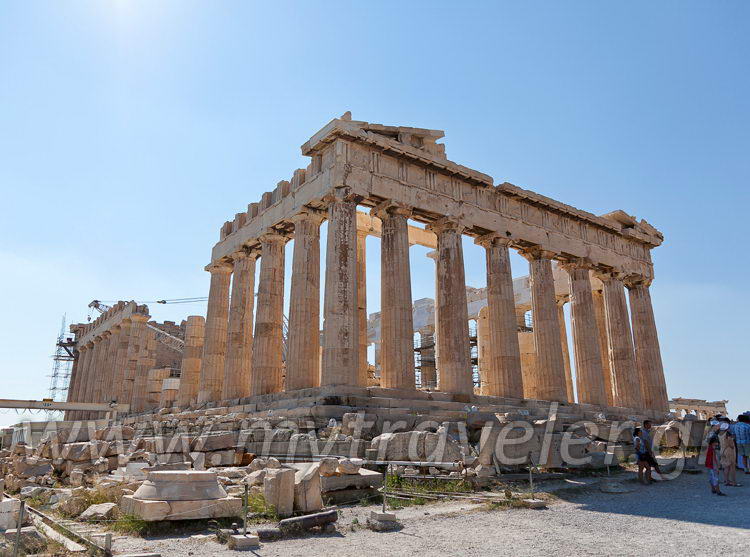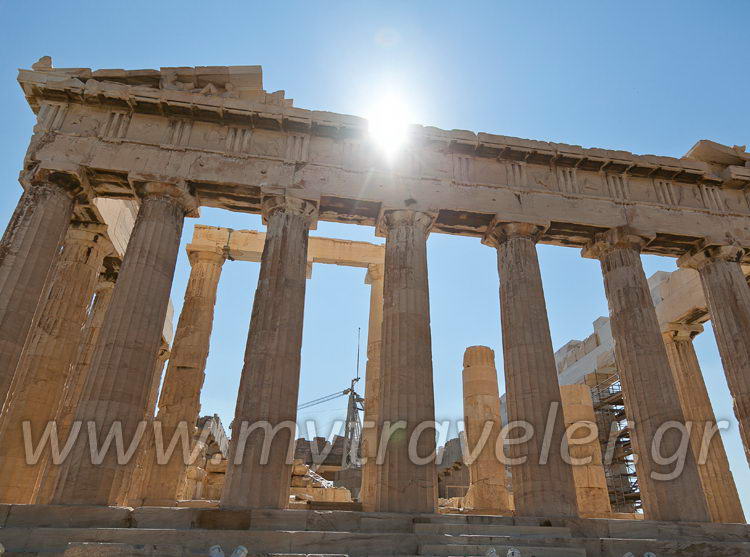Description
The Parthenon, dedicated by the Athenians to Athena Parthenos, the patron of their city, is the most magnificent creation of Athenian democracy at the height of its power. It is also the finest monument on the Acropolis in terms of both conception and execution. Built between 447 and 438 BC, as part of the greater Periklean building project, this so-called Periklean Parthenon (Parthenon III) replaced an earlier marble temple (Parthenon II), begun after the victory at the battle of Marathon at approximately 490 BC and destroyed by the Persians in 480 BC. This temple had replaced the very first Parthenon (Parthenon I) of c. 570 BC. The Periklean Parthenon was designed by architects Iktinos and Kallikrates, while the sculptor Pheidias supervised the entire building program and conceived the temple's sculptural decoration and chryselephantine statue of Athena.
The Parthenon is a double peripteral Doric temple with several unique and innovative architectural features. The temple proper is divided into pronaos, cella and opisthodomos, with a separate room at the west end, and is surrounded by a pteron with eight columns on each of the short sides and seventeen columns on the long ones. The columns had the same width as those of Parthenon II, so that use was made of the material prepared for it, even though the new temple was much broader than its predecessor. The interior demonstrates an innovative approach to both new and old elements: inside the cella a double pi-shaped colonnade established a background for the gold and ivory statue of Athena Parthenos, which showed the goddess in full armour carrying Nike (Victory) to the Athenians in her right hand. The west room, where the city's treasures were kept, had four Ionic columns. The two-sloped wooden roof had marble tiles, marble palmette-shaped false antefixes along the edge of its long sides and false spouts in the shape of lion heads at the corners. Marble statues adorned the corners of the pediments and large, ornate palmettes their apex. The pediments were decorated with sculptural compositions inspired from the life of the goddess Athena. The east pediment depicted the birth of the goddess, who sprang from the head of her father, Zeus, before an assembly of the Olympian gods, while the west pediment showed Athena and Poseidon disputing for the possession of the city of Athens before the gods, heroes and mythical kings of Attica. Ninety-two metopes alternating with triglyphs were placed above the epistyle of the outer colonnade and under the architrave. All of them were adorned with reliefs, the earliest sculptures of the Parthenon. Their themes were derived from legendary battles: the Gigantomachy was depicted on the eastern side, the Trojan War on the northern side, the Amazonomachy on the western side and the Centauromachy on the southern side. The frieze, an element of the Ionic order, brilliantly added to this Doric temple along the top of the cella, pronaos and opisthodomos, depicted the splendid procession of the Panathinaia, the greatest festival of Athens in honour of Athena.
The Parthenon remained unchanged until the fifth century AD, when it was converted into a church dedicated first to Saint Sophia and later to the Panagia (Virgin Mary). Under Turkish rule it became a mosque. In 1687, during the siege of the Acropolis by Morozini, the Parthenon was bombarded and largely destroyed. Further serious damage was caused in the early nineteenth century by Lord Elgin, who looted much of the temple's sculptural decoration and sold it to the British Museum. Conservation and restoration of the Parthenon took place in 1896-1900 and again in 1922-1933. A vast conservation and restoration program of the monuments of the Acropolis, including the Parthenon, is currently under way since 1975 by the Service of Restoration of the Monuments of the Acropolis in collaboration with the First Ephorate of Prehistoric and Classical Antiquities, under the supervision of the Committee for the Conservation of the Monuments of the Acropolis.
The Parthenon is a double peripteral Doric temple with several unique and innovative architectural features. The temple proper is divided into pronaos, cella and opisthodomos, with a separate room at the west end, and is surrounded by a pteron with eight columns on each of the short sides and seventeen columns on the long ones. The columns had the same width as those of Parthenon II, so that use was made of the material prepared for it, even though the new temple was much broader than its predecessor. The interior demonstrates an innovative approach to both new and old elements: inside the cella a double pi-shaped colonnade established a background for the gold and ivory statue of Athena Parthenos, which showed the goddess in full armour carrying Nike (Victory) to the Athenians in her right hand. The west room, where the city's treasures were kept, had four Ionic columns. The two-sloped wooden roof had marble tiles, marble palmette-shaped false antefixes along the edge of its long sides and false spouts in the shape of lion heads at the corners. Marble statues adorned the corners of the pediments and large, ornate palmettes their apex. The pediments were decorated with sculptural compositions inspired from the life of the goddess Athena. The east pediment depicted the birth of the goddess, who sprang from the head of her father, Zeus, before an assembly of the Olympian gods, while the west pediment showed Athena and Poseidon disputing for the possession of the city of Athens before the gods, heroes and mythical kings of Attica. Ninety-two metopes alternating with triglyphs were placed above the epistyle of the outer colonnade and under the architrave. All of them were adorned with reliefs, the earliest sculptures of the Parthenon. Their themes were derived from legendary battles: the Gigantomachy was depicted on the eastern side, the Trojan War on the northern side, the Amazonomachy on the western side and the Centauromachy on the southern side. The frieze, an element of the Ionic order, brilliantly added to this Doric temple along the top of the cella, pronaos and opisthodomos, depicted the splendid procession of the Panathinaia, the greatest festival of Athens in honour of Athena.
The Parthenon remained unchanged until the fifth century AD, when it was converted into a church dedicated first to Saint Sophia and later to the Panagia (Virgin Mary). Under Turkish rule it became a mosque. In 1687, during the siege of the Acropolis by Morozini, the Parthenon was bombarded and largely destroyed. Further serious damage was caused in the early nineteenth century by Lord Elgin, who looted much of the temple's sculptural decoration and sold it to the British Museum. Conservation and restoration of the Parthenon took place in 1896-1900 and again in 1922-1933. A vast conservation and restoration program of the monuments of the Acropolis, including the Parthenon, is currently under way since 1975 by the Service of Restoration of the Monuments of the Acropolis in collaboration with the First Ephorate of Prehistoric and Classical Antiquities, under the supervision of the Committee for the Conservation of the Monuments of the Acropolis.
Published: 7 Aug. 2011
Add to favorite
- Information -
| (+30)-2103-214-172 |
| (+30)-2103-210-219 |
| (+30)-2109-238-724 |
| (+30)-2109-239-023 |
| odysseus.culture.gr |
| GPS Coordinates |
| 37.971479 , 23.726696 |
| 37° 58' 17,3244"N , 23° 43' 36,1056"E |
Where to stay
accommodations located nearby
More Holiday Ideas
what else you can see here around

